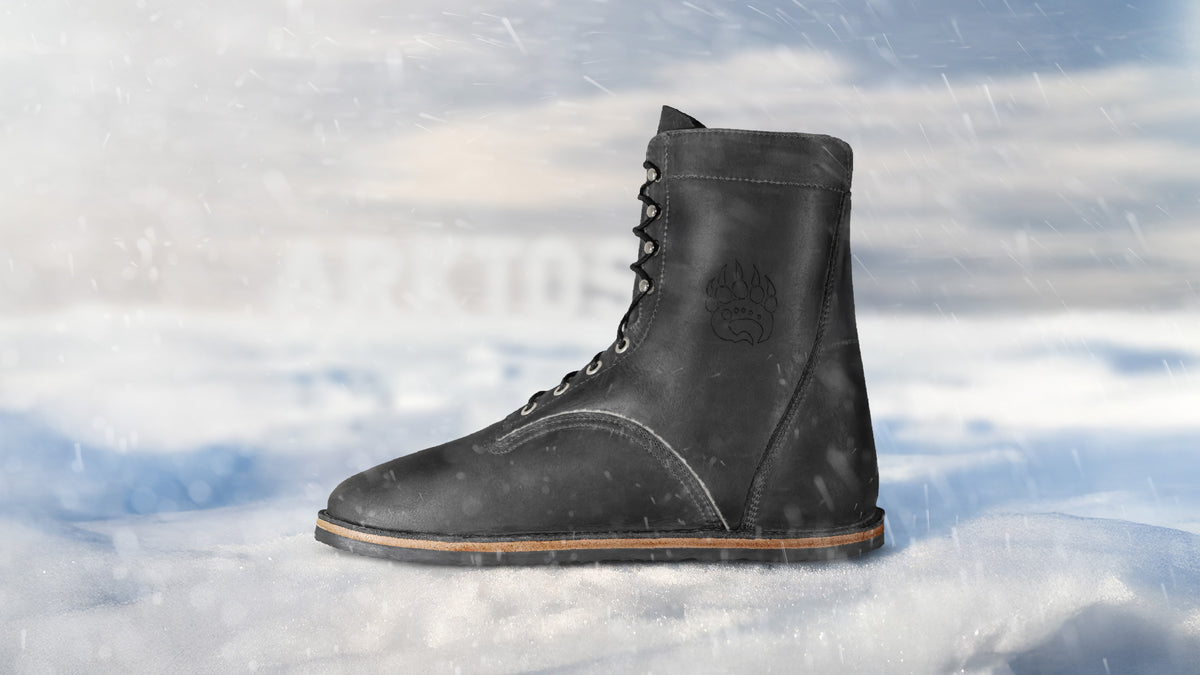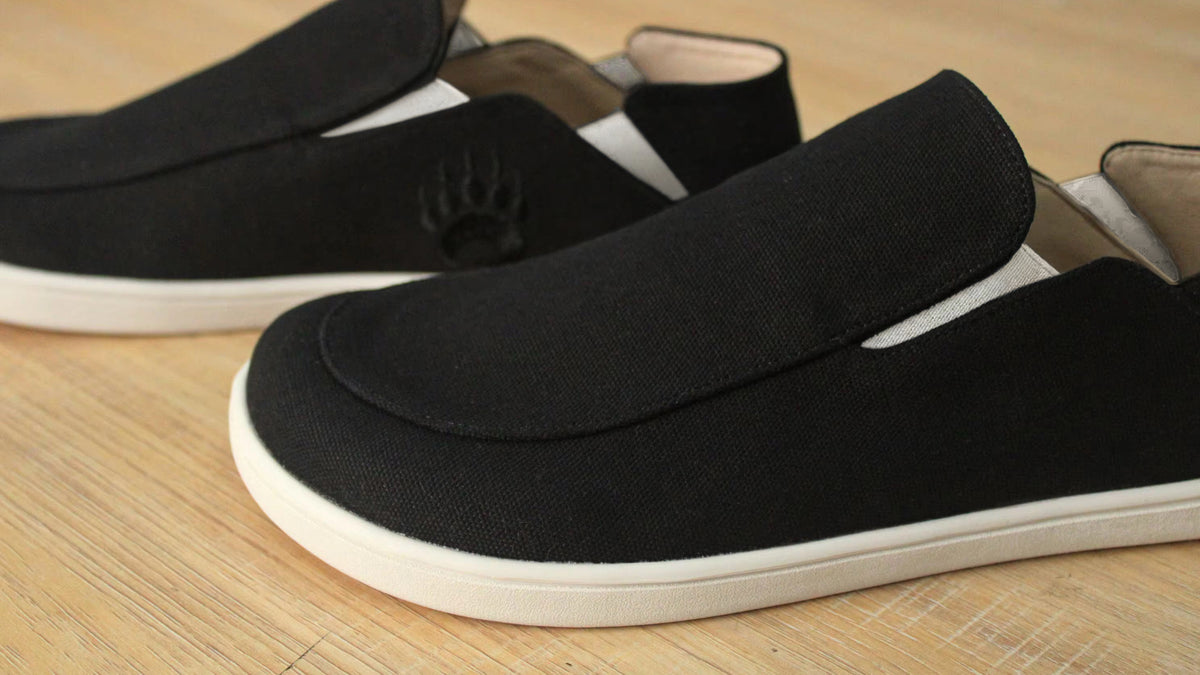A Better Way to Lace your Barefoot Shoes for High Arches
By Lily Hoog-Fry & John Baker of Swell Movement & Longevity
A high instep is when there is an increase in the height of the medial longitudinal arch of the foot. This gives a characteristic high-arch resting position in which you can slide your fingers under the inside (medial side) of your feet further than normal.
To visualize what this really means, think about if you dipped the sole of your foot in ink. Your entire foot is covered in ink, but as you place your foot on the ground, only the portions that actually come into contact with the ground will transfer ink. If you have a flat or non-existent arch, a lot of ink will get transferred through the middle of the foot. However, if your foot’s ink-print has a well defined ball and heel barely connected by a thin or non-existent strip, you likely have high arches or pes cavus.
Now, we’ve covered this condition in depth here. But the short of it is, this condition changes the biomechanics of the foot and increases the risk of developing a plethora of common problems such as plantar fasciitis, Morton’s neuroma (nerve entrapment between your toe bones), bunions, stress fractures, metatarsalgia (inflammation of the ball of your foot) and ankle sprains. What a list, right?
The traditional thinking to treat the foot pain associated with a high arched foot, is to brace the foot with arch support. While this is appropriate occasionally when there is a structural issue, anytime you brace something, it gets weaker. So, unless you never want your foot to be stronger and you want to rely on external support forever, this isn’t a mechanically sound first step.
Although it may be surprising, the way we lace our shoes affects how well they work for us. Read on for a review of common lacing techniques, when and why to use them and how to optimally care for your high arches with simple changes.
Common Lacing Strategies for High Arches:
Many of us just lace our shoes and hit the road, without giving it much thought. But the way we lace our shoes affects not only the correct fit of our shoes, but the forces on our foot, and by proxy, all our other weight bearing parts.
The common lacing pattern given by manufacturers of traditional running shoes for high arches goes something like this:
-
Use a parallel pattern of lacing where you skip crossing your laces in the areas where you need more space
-
This allows you to accommodate the increased depth of the middle section of your foot from your high instep
-
Said another way, pass the lace through the eyelet directly above, instead of the eyelet on the opposite side of the shoe’s tongue, before you continue to zig zag over the top of your foot
-
This is referred to as “parallel” or “Lydiard lacing” (there are so many different variations and names of these shoe lacing techniques it cracks us up, “bar lacing, gap lacing, lock lacing” the list goes on)
... And while this isn’t necessarily bad advice, it isn’t actually supported by science (yet) and misses the adequate nuance to empower you to make the best choices for your high arches. Read on to learn why.
What Science Does Say:
When comparing a variety of lacing methods in running men, lacing the shoes through every eyelet (yes, even those final eyelets many of us ignore) moderately tightly, resulted in less forces through the foot, as well as decreased pronation speed (Hagen & Hennig, 2009).
Ok, cool big words guys, but what does that mean? We can all understand that having less overall force through the foot seems like the better option. But what about the pronation piece?
Pronation of the foot is the action that occurs when you flatten your arch. It is often thought of as generally bad, because in excess, it leads to a lot of knee, hip and foot problems. However, we need to pronate every time we take a step, because otherwise it would be impossible to get the base of the big toe, or the medial side of the ball of the foot, to touch the ground. Thus, a better way to think about it is, that over-pronation or uncontrolled pronation is problematic, but pronation in general is normal and meant to occur.
Why is getting the big toe down important? The first ray (the big toe to where it meets the ankle) was designed to take over half of all our body weight when we walk (~60%). If we can’t get it on the ground, this load gets put on structures that weren’t made to bear it, which overtime causes problems. Not to mention, when we load the big toe effectively, we can recruit the posterior chain (fancy word for all the muscles on the back of the body) to help move us forward with ease (this is why orthotics are necessary if your high arch is structural or rigid, which is rare) – hello beautiful buns and thighs!
However, if we can’t control the speed of pronation, we jam into passive structures on the inside of the foot with every step, and are thus more likely to roll an ankle, develop bunions and have big toe pain. So maybe the advice to unlace your shoes in a variety of fancy ways isn’t the best advice, because it ultimately makes your shoes looser which increases the speed of pronation while also increasing the overall force on your foot.
Additionally, loose fitting shoes change how your foot contacts the ground because you have to try to keep the shoe on your foot, to prevent heel slippage, black toenails and hot spots on the inside of the shoe. So, instead of the lateral heel striking first, the whole foot touches down at once which completely destroys the spring mechanism of the foot. This can lead to toe clawing or shortening of the muscles on the bottom of your foot which perpetuates foot dysfunction and requires more help from your foot’s fascia (hint: think plantar fasciitis pain). It can also cause excessive wear of your shoes because the load isn't dispersed well over the entire shoe, but localized.
The Context of Different Lacing Techniques Matters:
This science above isn’t perfect – they only looked at about 20 well-trained guys running in normal padded shoes (can we get some lady data in the house?!). But, on the other hand, the advice to loosen your shoes with various lacing techniques isn’t validated by any science (hopefully a researcher reading will fix this) and there are some serious downsides to your shoes being too loose.
With this said, the nuance required for the reality of our bodies means that in some cases both options may be right. If you’re already dealing with foot issues caused by compression like a painfully wide forefoot or Morton’s neuroma, use different lacing techniques to adjust the toe box of your barefoot shoes to make your shoes bearable (pun intended), and looser fitting.
It may also be a good choice to lace your shoes looser if you’ve been diligently training your foot strength, aren’t dealing with foot injuries, and want to train your foot in a different way i.e. training your foot to work harder to control pronation and load (though we’d recommend banded, pronation specific training first).
If you’re dealing with issues like plantar fasciitis, stress fractures or bunions in which more force dampening and control is needed, just changing your lacing style isn’t a great first step. This may make your shoes more comfortable, but requires more work from the structures that are already injured – so lace those shoes up.
Another recommended reason you might tighten your laces and use all the eyelets would be for walking long distances or running, as this will increase performance and ease by giving you greater support and force dampening.
Wrapping it Up:
Of course, your pair of shoes needs to correctly fit your foot size and shape without your heel slipping or squeezing your foot to be more narrow, for any of these nuances to really matter (think a front of the shoe that's actually shaped like a foot and other key characteristics of barefoot style shoes). But as you continue to move and train hard in your barefoot shoes, keep these principals in mind when you're choosing the best shoe lacing technique for your high arched feet and really, your whole body.




























